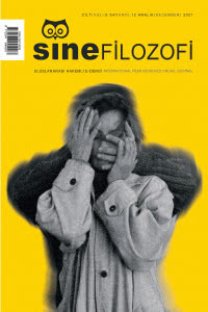Bir Flaneuse Yolculuğu Olarak 'İşe Yarar Bir Şey'
‘Something Useful’ as a Flaneuse Journey
___
- Alver, K. (2012), Flaneur: A Modern Urban Figure, Akademik İncelemeler Dergisi, 7(2), 285-293.
- Akın, G. (2016), Kırmızı Karanfil, İstanbul: Yapı Kredi.
- Artun, A.(2009), Modern Hayatın Ressamı, Sunuş Bölümü, İstanbul: İletişim.
- Bakhtin, M. (2001), Karnavaldan Romana- Edebiyat Teorisinden Dil Felsefesine Seçme Yazılar (Çev. C. Soydemir). İstanbul: Ayrıntı.
- Bauman, Z. (1998), Postmodern Etik, (Çev. Alev Türker), İstanbul: Ayrıntı.
- Benjamin, W. (1973), Illuminations, Glasgow: Fontana
- Benjamin, W. (1990), Benjamin, Baudelaire ve Pasajlar. (Çev. A. Cemal). Argos, Cilt: 28: 50-52.
- Boutin, A. (2012), Flâneur’u Yeniden Düşünmek: Flânerie ve Duyular, Dix-Neuviémistes Derneği Dergisi, Cilt 16, Sayı 2.
- Burton, R. (1988), The Unseen Seer, or Proteus in the City: Aspects of a Nineteenth-Century Parisian Myth. French Studies, 42(1): 50–68.
- Chan, H. (2018), Cléo from 5 to 7 and the Performance of the Flâneuse, Caméra Stylo, 18.
- Demirkıran, Y. (2017), 19. Yüzyıl Erken Modern Kent Karakteri Olarak Charles Baudelaire’in Flaneur Kavramı’nın Yeni Medya’daki İzdüşümü, Sanat ve Tasarım Dergisi, (20), 105-121.
- Dreyer, E. ve McDowall, E. (2012), Imagining the Flâneur as a Woman.Communicatio,38(1), 30-44.
- Erkek, F. (2019), Walter Benjamin’de Sanat, Estetik ve Politika İlişkisi (Yayınlanmamış Doktora Tezi). Ankara Üniversitesi Sosyal Bilimler Enstitüsü, Ankara.
- Esmer, P. ve Kalvo, M. (Yapımcı), Esmer, P. (Yönetmen). (2017). İşe Yarar Birşey [Sinema Filmi]. Türkiye, Fransa, Almanya ve Hollanda: SineFilm ve Mars Prodüksiyon.
- Gleber, A. (1997), Female Flâneurie and the Symphony of the City, 67–88. Berkeley, Los Angeles and London: University of California.
- Gleber, A. (1999), The Art of Taking a Walk: Flânerie, Literature, and Film in Weimar Culture. Princeton: Princeton University.
- Gluck, M. (2003), Flâneur ve Estetik: 19. Yüzyıl Ortası Paris‘te Kent Kültürünün Sahiplenilmesi. Teori, Kültür ve Toplum, 20 (5): 53 - 80.
- Goebel, R. J. (1998), Benjamin’s Flâneur in Japan: Urban Modernity and Conceptual Relocation. German Quarterly, 377-391).
- İlgürel, M. (2016), Julio Cortazar’ın Öykülerinin Sembolik İmgelemi, İstanbul: Yeni İnsan.
- Karakuş, G. ve Ötgün, C. (2020), Simurg Söyleninde Kuş İmgesi. Fine Arts, 15(2), 99-115.
- Kuçuradi, İ. (2011), Etik. Ankara: Türkiye Felsefe Kurumu.
- La Rocca, F. (2017), A Theoretical Approach to the Flâneur and the Sensitive Perception of the Metropolis. Dans Sociétés (n° 135), pages 9 à 17).
- Mc Garrigle, C. (2014), Forget the Flâneur. Proceedings of the 19th International Symposium on Electronic Art. Sydney, Australia. doi:10.21427/bezf-s927.
- Pile, S. (1996), The Body and the City: Psychoanalysis, Space and Objectivity. London and New York: Routledge.
- Pollock, G.(1988), Vision and Difference: Femininity, Feminism, and the Histories of Art. London: Routledge.
- Sevim, B. A. (2010), Walter Benjamin’in Kavramlarıyla Kültür Endüstrisi:” Aura”,” Öykü Anlatıcısı” ve” Flâneur.”. Journal of International Social Research, 3(11).
- Shaya, G. (2004), The Flaneur, the Badaud, and the Making of a Mass Public in France, circa 1860-1910. American Historical Review, 109(1), 41-77.
- Swanson, G. (1995), ‘Drunk with the glitter’: Consuming spaces and sexual geographies. In Postmodern Spaces and Sexual Geographies, ed. S. Watson and K. Gibson, 80–98. Oxford: Blackwell.
- Tseng, C. F. (2006), The Flaneur, the Flaneuse, and the Hostess: Virginia Woolf’s (Un) Domesticating Flanerie in” Mrs. Dalloway”. Concentric: Literary and Cultural Studies, 32(1), 219-258.
- Ward, S. (2005), The Passenger As Flâneur? Railway networks in German-language fiction since 1945. The Modern Language Review, 412-428.
- Wilson, E. (1992), The Invisible Flâneur. New Left Review, 191(1), 90-110.
- Wolff, J. (1985), The Invisible Flâneuse: Women and the Literature of Modernity, Theory, Culture and Society 2.3, 37-46.
- Zambak, F. (2017), Demiryolu Hikâyecileri - Bir Rüyayı Yeniden Görmek. Akademik Sosyal Araştırmalar.(63),336-344.
- https://www.antoloji.com/insan-ve-deniz-siiri (12.01.2021 tarihinde erişildi).
- https://dictionary.cambridge.org/flaneur (17.11.2020 tarihinde erişildi).
- https://filmhafizasi.com/ise-yarar-bir-sey-pelin-esmer-ile-siirsel-bir-yolculuk-soylesisi (25.12.2020 tarihinde erişildi).
- https://www.lexico.com/definition/flaneur (17.11.2020 tarihinde erişildi).
- https://sozluk.gov.tr (03.01.2021 tarihinde erişildi)
- Yayın Aralığı: 2
- Başlangıç: 2016
- Yayıncı: Serdar Öztürk
Hegel'de Bilinç ve Özgürlük İlişkisi Bağlamında Karakter FilmiÜzerineBirİnceleme
Posthuman Subjectivity and Implied Dreams in Animation Cinema
Tony Gatlif’in Aksanlı Sinemasına Deleuzyen Bir Bakış
Ahmet Oktan, Almıla Nur Berilğen
Kurtuluş ÖZGEN, Işkın ÖZBULDUK KILIÇ
Kurtuluş ÖZGEN, Işkın ÖZBULDUK KILIÇ
Tschumi’de Olay, Mimaride Kopma, Sinemada Benlik
Bir Flaneuse Yolculuğu Olarak 'İşe Yarar Bir Şey'
Hegel'in Aufhebung'u Beoning (2018) Filminde Olamayanı Aramak
